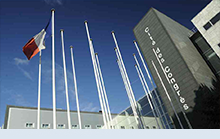 |
European Planetary Science Congress 2015
27 September – 02 October 2015
La Cité des Congrès, Nantes, France |
 |

|
AB2 Planetary Habitability in the Solar System and Beyond |
| Convener: Véronique Dehant | Co-Conveners: Olga Prieto-Ballesteros , Frances Westall , Lena Noack , Doris Breuer , Tilman Spohn |
|
Oral Program
/ Thu, 01 Oct, 16:00–17:30
/ Room Venus
Poster Program
/ Attendance Thu, 01 Oct, 17:45–19:15
/ Poster Area
|
Earth clearly stands out among the rocky planets of the inner Solar System. It harbors life, has water oceans, volcanic activity contributing to the atmosphere and plate tectonics continuously regenerating its surface. Its biosphere is shielded from radiation and a self-sustained magnetic field protects its atmosphere from erosion. Connections thus exist between the presence of life and the geophysical characteristics of the host planet. Other bodies such as Mars, Venus and some large satellites like Europa do share some but not all of Earth’s geophysical properties, and life seems absent there or at least not as abundant as on the Earth. The origin, evolution and distribution of life in the universe constitute crucial questions that will be examined during the session. Since Mars provides the ideal opportunity of finding extraterrestrial life, space agencies have defined the search for life on Mars as a major priority. However, this search can yield negative results even if Martian life exists now or occurred in the past. For this reason the search for life must be paired with research to define the potential of a planet to host and sustain life, i.e. its habitability. Investigation of Mars geology and geophysics to ascertain its habitability represents a second important goal of the Mars missions carried out by NASA with the Mars Exploration Rovers (MERs) or the Mars Science Laboratory (MSL) and ESA with its ExoMars mission. The session will thus address the search for life and potentially habitable conditions on Mars and other planets.
